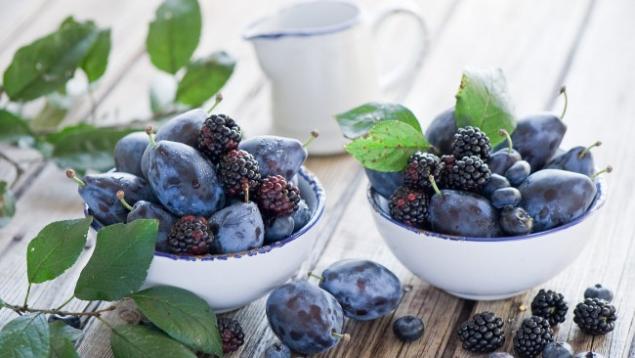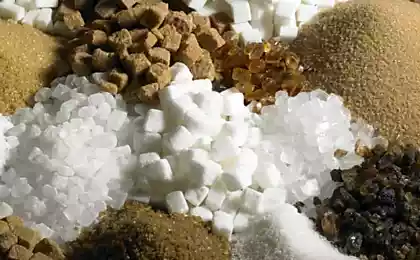584
Plums contain the sugar substitute sorbitol
Delicious and juicy plums belong to the family Rosaceae and the genus Prunus. Other members of the genus Prunus — peaches, nectarines, almonds, and damson.
The scientific name for plums is Prunus domestica. The plant is a small tree or large shrub. In the world of different cultivated varieties of plums come in different sizes, colors and shapes. The diameter of the drain reaches 5 — 6 inches, and weigh a single fruit maybe 50-70 grams. These fruits, like beans, help to normalize digestion.
Plums have juicy and fleshy pulp, the color of which depending on grade can be creamy yellow, crimson, light blue or light green. Resource Nutrotion And You made a list of those qualities that make the plum is not only delicious, but also very useful fruit.
However, any information about the benefits of certain plants should be taken only as an auxiliary and before the introduction of the product in the diet must be consulted with a doctor, especially in the presence of certain diseases or contraindications.
Plums are "stone" fruits. This means that in the center of each plum in special deepening is her only solid seed. Plum stones are inedible.
Use drain health

Plums are low in calories (46 calories per 100 grams) and contain no saturated fats and they are rich in numerous restorative health substances, vitamins and minerals.
Among health enhancing compounds contained in plums, — dietary fibre, sorbitol (sorbitol) and satin that helps in normal functioning of the digestive system and in result prevents constipation.
The total antioxidant level drain (figure ORAC — Oxygen radical absorbance capacity) is 6259 µmol TE / 100 grams. Fresh plums in moderation contain vitamin C, a powerful natural antioxidant. Eating foods rich in vitamin C, helps the body to counteract the inflammatory processes and to be cleansed from harmful free radicals of oxygen.
Fresh plums, especially the variety mirabelle (Mirabelle), are a source of vitamin A and beta-carotene contained in them in moderation. Vitamin a is essential for healthy vision. It is also required to maintain healthy skin and mucous membranes. It was discovered that eating food rich in vitamin A natural fruit helps to protect from lung cancer and oral cavity.
Plums also contain strengthening health flavonoid polyphenolic antioxidants, including lutein, cryptoxanthin, and zeaxanthin, which are present in plums in large quantities. These compounds act as scavengers of free radicals and reactive oxygen species that play a role in the development of various diseases and the aging process. Zeaxanthin is an important dietary carotenoid, selectively absorbed by the yellow spot of the retina, and it is believed that it plays a role of an antioxidant and performs Sitophilus functions in relation to ultraviolet light.
Plums abound in minerals such as potassium, fluoride and iron. Iron is essential for the formation of red blood cells. Potassium is an important component fluids of the cells and organism, helps control heart rate and blood pressure.
In addition, plums are a moderate source of B-complex vitamins, including Niacin and Pantothenic acid and vitamin B6. These vitamins act as co-factors help the body metabolize carbohydrates, protein and fats. In plums also contains 5% of recommended daily value of vitamin K. Vitamin K is important for the function of many blood coagulation factors, bone metabolism. It also helps to reduce the negative effects of Alzheimer's disease in the elderly.
Caution
In plums contain oxalic acid, a naturally occurring compound that is found in some vegetables and fruits, which in some people may crystallize into oxalate stones in the urinary tract. So those people who have oxalate stones, it is not recommended to consume plums in the food. If they still want to eat plums, they are encouraged to use water in sufficient quantities.Nutritional value of plums
In parentheses are the percentage of the daily allowance. Nutritional value is based on 100 grams of fresh plums (Prunus domestica) according to information from the Ministry of agriculture of the USA, shown in the resource Nutrition And You.
General information:
energetic value 46 kilocalories (2,3%);
carbohydrates — 11.42 grams (8%);
protein — 0.70 grams (1%);
fats — 0.28 grams (1%);
fiber, part of the food of 1.40 grams (3.5 per cent).
Vitamins:
folic acid (vitamin B9) — 5 micrograms (1%);
nicotinic acid (vitamin B3) — 0,417 milligram (3%);
Pantothenic acid — 0.135 milligram (3%);
pyridoxine (vitamin B6) — 0.029 milligrams (2%);
Riboflavin (vitamin B2) — 0,026 mg (2%);
thiamine (vitamin B1) — 0.028 milligram (2%);
vitamin a, which very much is contained in dandelion — 345 international units (IU, IU) — 11,5%;
vitamin C is 9.5 milligrams (16%);
vitamin E — 0.26 mg (2%);
vitamin K, an incredibly rich source of which is sage — 6.4 micrograms (5%).
Electrolytes:
sodium — 1 milligram (~0%);
potassium — 157 mg (3%).
Minerals:
calcium — 6 mg (0.6 per cent);
copper — 0,057 mg (6%);
iron — 0.17 mg (2%);
magnesium — 7 mg (2%);
manganese — 0,052 milligrams (2%);
phosphorus 16 mg (2%);
selenium — 1.0 micrograms (2%);
zinc — 0.10 mg (1%).
Phytonutrients:
beta-carotene (ß-carotene), which is rich in carrots — 190 micrograms;
beta-cryptoxanthin (β-cryptoxanthin) is 35 micrograms;
lutein-zeaxanthin — 73 micrograms.
published
P. S. And remember, only by changing their consumption — together we change the world! © Join us at Facebook , Vkontakte, Odnoklassniki
Source: hi-news.ru
The scientific name for plums is Prunus domestica. The plant is a small tree or large shrub. In the world of different cultivated varieties of plums come in different sizes, colors and shapes. The diameter of the drain reaches 5 — 6 inches, and weigh a single fruit maybe 50-70 grams. These fruits, like beans, help to normalize digestion.
Plums have juicy and fleshy pulp, the color of which depending on grade can be creamy yellow, crimson, light blue or light green. Resource Nutrotion And You made a list of those qualities that make the plum is not only delicious, but also very useful fruit.
However, any information about the benefits of certain plants should be taken only as an auxiliary and before the introduction of the product in the diet must be consulted with a doctor, especially in the presence of certain diseases or contraindications.
Plums are "stone" fruits. This means that in the center of each plum in special deepening is her only solid seed. Plum stones are inedible.
Use drain health

Plums are low in calories (46 calories per 100 grams) and contain no saturated fats and they are rich in numerous restorative health substances, vitamins and minerals.
Among health enhancing compounds contained in plums, — dietary fibre, sorbitol (sorbitol) and satin that helps in normal functioning of the digestive system and in result prevents constipation.
The total antioxidant level drain (figure ORAC — Oxygen radical absorbance capacity) is 6259 µmol TE / 100 grams. Fresh plums in moderation contain vitamin C, a powerful natural antioxidant. Eating foods rich in vitamin C, helps the body to counteract the inflammatory processes and to be cleansed from harmful free radicals of oxygen.
Fresh plums, especially the variety mirabelle (Mirabelle), are a source of vitamin A and beta-carotene contained in them in moderation. Vitamin a is essential for healthy vision. It is also required to maintain healthy skin and mucous membranes. It was discovered that eating food rich in vitamin A natural fruit helps to protect from lung cancer and oral cavity.
Plums also contain strengthening health flavonoid polyphenolic antioxidants, including lutein, cryptoxanthin, and zeaxanthin, which are present in plums in large quantities. These compounds act as scavengers of free radicals and reactive oxygen species that play a role in the development of various diseases and the aging process. Zeaxanthin is an important dietary carotenoid, selectively absorbed by the yellow spot of the retina, and it is believed that it plays a role of an antioxidant and performs Sitophilus functions in relation to ultraviolet light.
Plums abound in minerals such as potassium, fluoride and iron. Iron is essential for the formation of red blood cells. Potassium is an important component fluids of the cells and organism, helps control heart rate and blood pressure.
In addition, plums are a moderate source of B-complex vitamins, including Niacin and Pantothenic acid and vitamin B6. These vitamins act as co-factors help the body metabolize carbohydrates, protein and fats. In plums also contains 5% of recommended daily value of vitamin K. Vitamin K is important for the function of many blood coagulation factors, bone metabolism. It also helps to reduce the negative effects of Alzheimer's disease in the elderly.
Caution
In plums contain oxalic acid, a naturally occurring compound that is found in some vegetables and fruits, which in some people may crystallize into oxalate stones in the urinary tract. So those people who have oxalate stones, it is not recommended to consume plums in the food. If they still want to eat plums, they are encouraged to use water in sufficient quantities.Nutritional value of plums
In parentheses are the percentage of the daily allowance. Nutritional value is based on 100 grams of fresh plums (Prunus domestica) according to information from the Ministry of agriculture of the USA, shown in the resource Nutrition And You.
General information:
energetic value 46 kilocalories (2,3%);
carbohydrates — 11.42 grams (8%);
protein — 0.70 grams (1%);
fats — 0.28 grams (1%);
fiber, part of the food of 1.40 grams (3.5 per cent).
Vitamins:
folic acid (vitamin B9) — 5 micrograms (1%);
nicotinic acid (vitamin B3) — 0,417 milligram (3%);
Pantothenic acid — 0.135 milligram (3%);
pyridoxine (vitamin B6) — 0.029 milligrams (2%);
Riboflavin (vitamin B2) — 0,026 mg (2%);
thiamine (vitamin B1) — 0.028 milligram (2%);
vitamin a, which very much is contained in dandelion — 345 international units (IU, IU) — 11,5%;
vitamin C is 9.5 milligrams (16%);
vitamin E — 0.26 mg (2%);
vitamin K, an incredibly rich source of which is sage — 6.4 micrograms (5%).
Electrolytes:
sodium — 1 milligram (~0%);
potassium — 157 mg (3%).
Minerals:
calcium — 6 mg (0.6 per cent);
copper — 0,057 mg (6%);
iron — 0.17 mg (2%);
magnesium — 7 mg (2%);
manganese — 0,052 milligrams (2%);
phosphorus 16 mg (2%);
selenium — 1.0 micrograms (2%);
zinc — 0.10 mg (1%).
Phytonutrients:
beta-carotene (ß-carotene), which is rich in carrots — 190 micrograms;
beta-cryptoxanthin (β-cryptoxanthin) is 35 micrograms;
lutein-zeaxanthin — 73 micrograms.
published
P. S. And remember, only by changing their consumption — together we change the world! © Join us at Facebook , Vkontakte, Odnoklassniki
Source: hi-news.ru
Fathers and children: a vicious circle of resentment
10 recipes an excellent recipes of snacks for the winter























